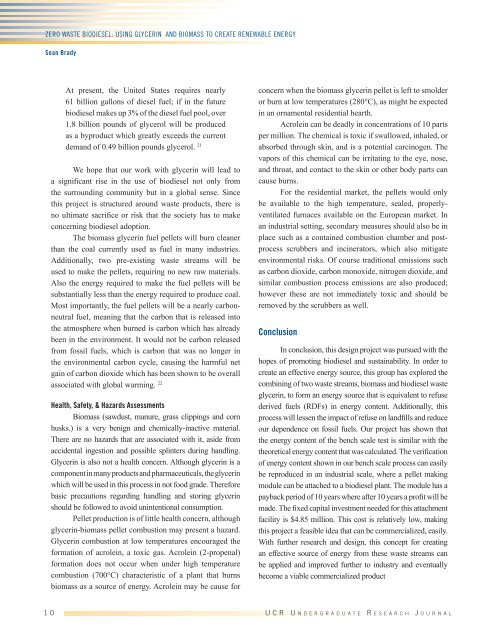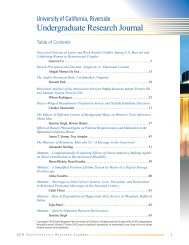UC Riverside Undergraduate Research Journal
UC Riverside Undergraduate Research Journal
UC Riverside Undergraduate Research Journal
Create successful ePaper yourself
Turn your PDF publications into a flip-book with our unique Google optimized e-Paper software.
Zero Waste Biodiesel: Using Glycerin And Biomass To Create Renewable Energy<br />
Sean Brady<br />
At present, the United States requires nearly<br />
61 billion gallons of diesel fuel; if in the future<br />
biodiesel makes up 3% of the diesel fuel pool, over<br />
1.8 billion pounds of glycerol will be produced<br />
as a byproduct which greatly exceeds the current<br />
demand of 0.49 billion pounds glycerol. 21<br />
We hope that our work with glycerin will lead to<br />
a significant rise in the use of biodiesel not only from<br />
the surrounding community but in a global sense. Since<br />
this project is structured around waste products, there is<br />
no ultimate sacrifice or risk that the society has to make<br />
concerning biodiesel adoption.<br />
The biomass glycerin fuel pellets will burn cleaner<br />
than the coal currently used as fuel in many industries.<br />
Additionally, two pre-existing waste streams will be<br />
used to make the pellets, requiring no new raw materials.<br />
Also the energy required to make the fuel pellets will be<br />
substantially less than the energy required to produce coal.<br />
Most importantly, the fuel pellets will be a nearly carbonneutral<br />
fuel, meaning that the carbon that is released into<br />
the atmosphere when burned is carbon which has already<br />
been in the environment. It would not be carbon released<br />
from fossil fuels, which is carbon that was no longer in<br />
the environmental carbon cycle, causing the harmful net<br />
gain of carbon dioxide which has been shown to be overall<br />
associated with global warming. 22<br />
Health, Safety, & Hazards Assessments<br />
Biomass (sawdust, manure, grass clippings and corn<br />
husks.) is a very benign and chemically-inactive material.<br />
There are no hazards that are associated with it, aside from<br />
accidental ingestion and possible splinters during handling.<br />
Glycerin is also not a health concern. Although glycerin is a<br />
component in many products and pharmaceuticals, the glycerin<br />
which will be used in this process in not food grade. Therefore<br />
basic precautions regarding handling and storing glycerin<br />
should be followed to avoid unintentional consumption.<br />
Pellet production is of little health concern, although<br />
glycerin-biomass pellet combustion may present a hazard.<br />
Glycerin combustion at low temperatures encouraged the<br />
formation of acrolein, a toxic gas. Acrolein (2-propenal)<br />
formation does not occur when under high temperature<br />
combustion (700°C) characteristic of a plant that burns<br />
biomass as a source of energy. Acrolein may be cause for<br />
concern when the biomass glycerin pellet is left to smolder<br />
or burn at low temperatures (280°C), as might be expected<br />
in an ornamental residential hearth.<br />
Acrolein can be deadly in concentrations of 10 parts<br />
per million. The chemical is toxic if swallowed, inhaled, or<br />
absorbed through skin, and is a potential carcinogen. The<br />
vapors of this chemical can be irritating to the eye, nose,<br />
and throat, and contact to the skin or other body parts can<br />
cause burns.<br />
For the residential market, the pellets would only<br />
be available to the high temperature, sealed, properlyventilated<br />
furnaces available on the European market. In<br />
an industrial setting, secondary measures should also be in<br />
place such as a contained combustion chamber and postprocess<br />
scrubbers and incinerators, which also mitigate<br />
environmental risks. Of course traditional emissions such<br />
as carbon dioxide, carbon monoxide, nitrogen dioxide, and<br />
similar combustion process emissions are also produced;<br />
however these are not immediately toxic and should be<br />
removed by the scrubbers as well.<br />
Conclusion<br />
In conclusion, this design project was pursued with the<br />
hopes of promoting biodiesel and sustainability. In order to<br />
create an effective energy source, this group has explored the<br />
combining of two waste streams, biomass and biodiesel waste<br />
glycerin, to form an energy source that is equivalent to refuse<br />
derived fuels (RDFs) in energy content. Additionally, this<br />
process will lessen the impact of refuse on landfills and reduce<br />
our dependence on fossil fuels. Our project has shown that<br />
the energy content of the bench scale test is similar with the<br />
theoretical energy content that was calculated. The verification<br />
of energy content shown in our bench scale process can easily<br />
be reproduced in an industrial scale, where a pellet making<br />
module can be attached to a biodiesel plant. The module has a<br />
payback period of 10 years where after 10 years a profit will be<br />
made. The fixed capital investment needed for this attachment<br />
facility is $4.85 million. This cost is relatively low, making<br />
this project a feasible idea that can be commercialized, easily.<br />
With further research and design, this concept for creating<br />
an effective source of energy from these waste streams can<br />
be applied and improved further to industry and eventually<br />
become a viable commercialized product<br />
10 <strong>UC</strong>R Un d e r g r a d u a t e Re s e a r c h Jo u r n a l














